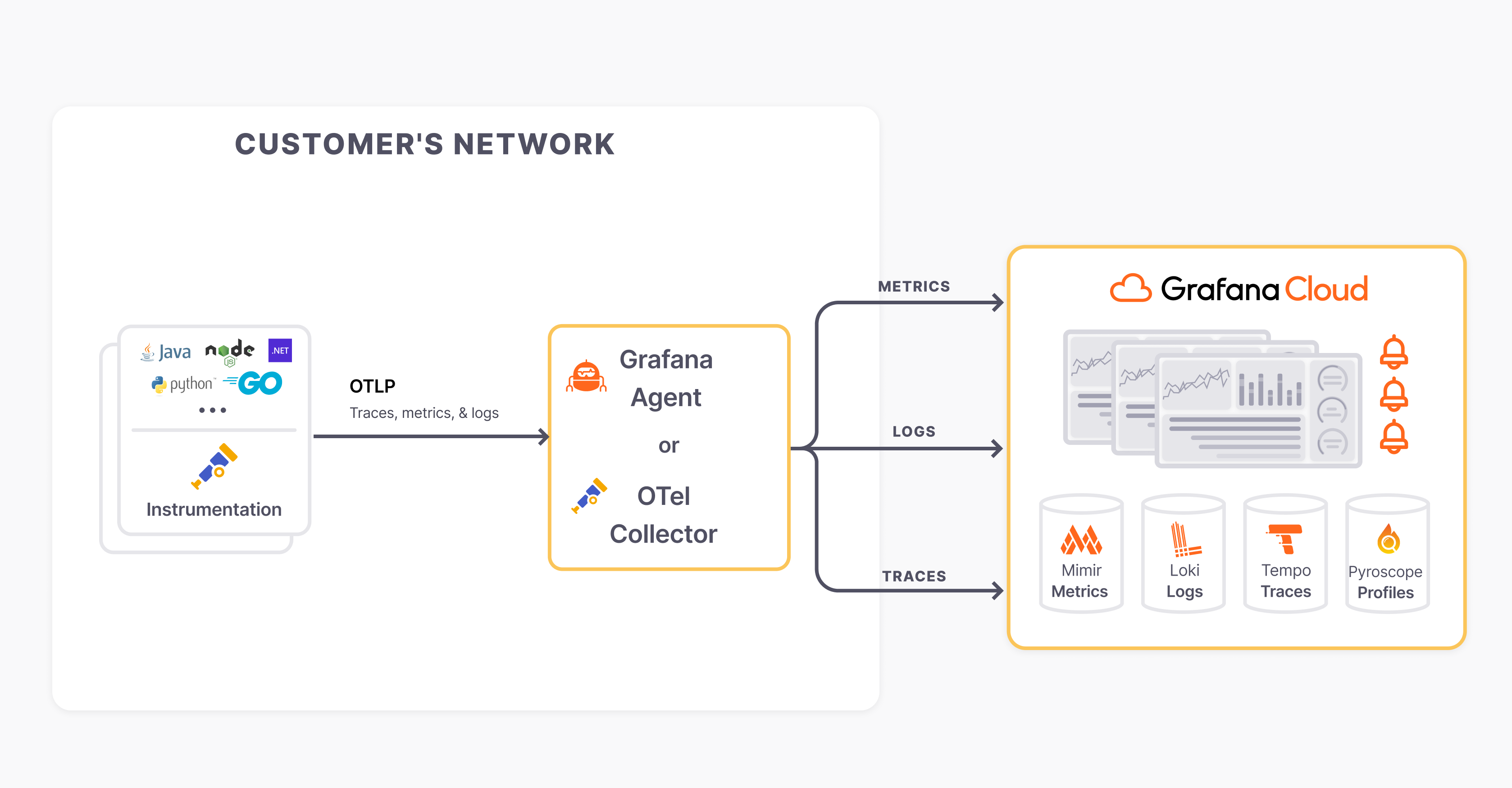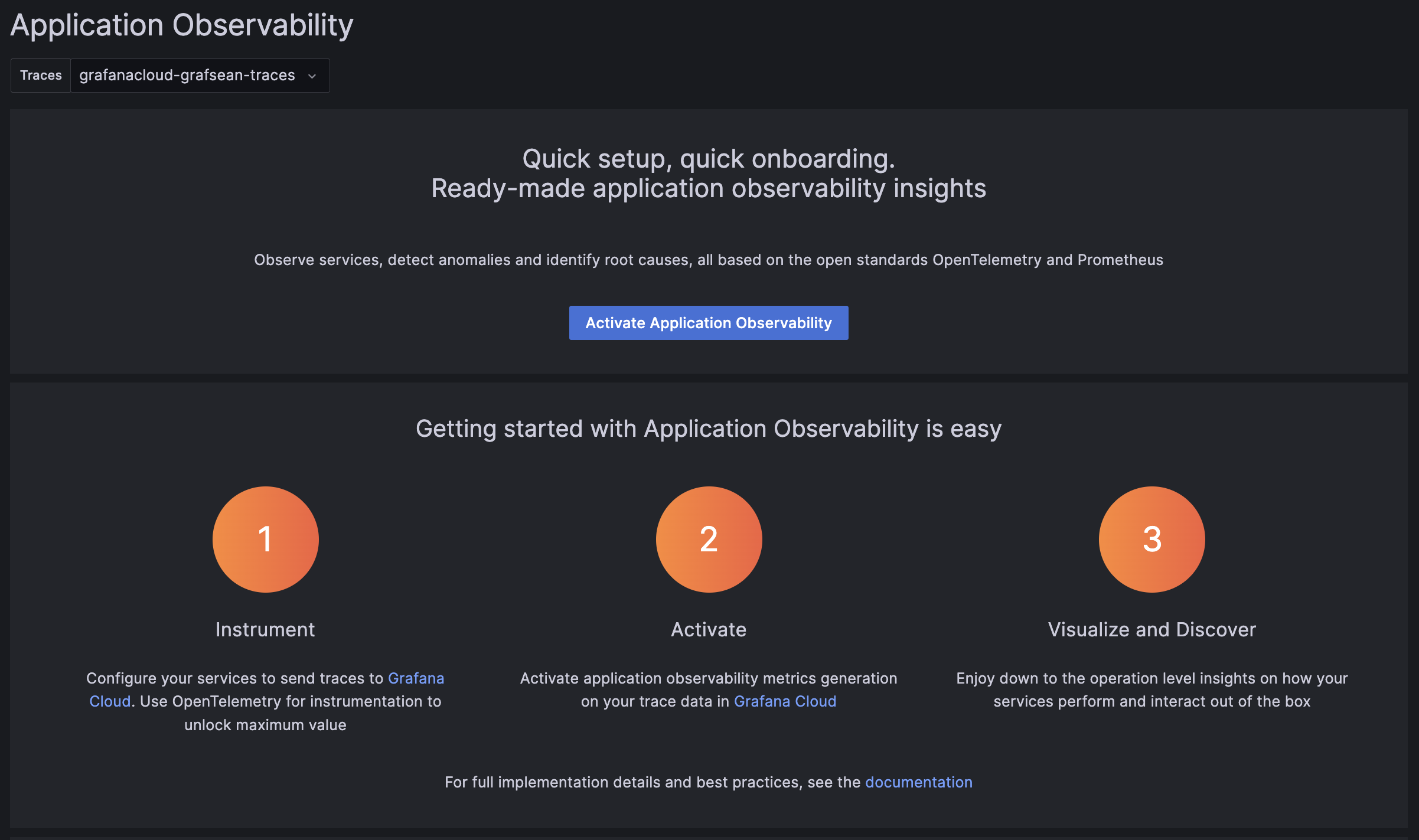Set up production instrumentation for Beyla
Follow these steps set up production Application Observability with a telemetry collector:
- Install the instrumentation library
- Configure an application
- Set up a telemetry data collector
- Run the application
- Observe the service in Application Observability
Note
For a quick and easy local development setup, consult the quickstart documentation.

Install the instrumentation library
Download the latest binary release of Grafana Beyla and uncompress it.
Alternatively, use the Grafana Beyla Docker image.
Configure an application
Next, customize the following shell script to configure an application:
export OTEL_SERVICE_NAME=<Service Name>
export OTEL_RESOURCE_ATTRIBUTES=deployment.environment=<Environment>,service.namespace=<Namespace>,service.version=<Version>,service.instance.id=<Instance>
# Don’t need BEYLA_EXECUTABLE_NAME if BEYLA_OPEN_PORT is already set
export BEYLA_EXECUTABLE_NAME=
# Don’t need BEYLA_OPEN_PORT if BEYLA_EXECUTABLE_NAME is already set
export BEYLA_OPEN_PORT=
export BEYLA_SERVICE_NAMESPACE=
sudo ./beyla
- Choose a Service Name to identify the service, for example
cart - Add attributes to filter data:
- deployment.environment: Name of the deployment environment (
stagingorproduction) - service.namespace: A namespace to group similar services
(e.g.
shopwould createshop/cartin Application Observability) - service.version: The application version, to see if a new version has introduced a bug
- service.instance.id: The unique instance, for example the Pod name (a UUID is generated by default)
- deployment.environment: Name of the deployment environment (
- An executable to instrument by specifying either:
- The executable file name, for example
nginx. - The server port, for example
443.
- The executable file name, for example
- Optional service attributes:
- A Service name to identify the service, for example
Frontend.
By default Beyla will use the executable name. - A Service namespace to group the service under in the plugin.
- A Service name to identify the service, for example
Note
Beyla requires administrative (sudo) privileges, or at least it needs to be granted theCAP_SYS_ADMINcapability.
Set up a telemetry data collector
In production environments, a robust and flexible observability setup needs to process telemetry data before ingestion into databases. Follow the collector setup documentation to set up a collector to process and send telemetry data to Application Observability.
Finally, set the following environment variables from the exporter configuration:
| Configuration | Options | Result |
|---|---|---|
export OTEL_EXPORTER_OTLP_ENDPOINT=<host> | http://localhost:4318, remote host address | The default local host address, or a remote host address. |
export OTEL_EXPORTER_OTLP_PROTOCOL=<protocol> | grpc, http/protobuf | The default http/protobuf protocol or grpc |
For example, for a local Grafana Alloy:
export OTEL_EXPORTER_OTLP_ENDPOINT=http://localhost:4317
export OTEL_EXPORTER_OTLP_PROTOCOL=grpcRun the application
Finally, run the application with the shell script and make some requests to the service to send data to Grafana Cloud.
Observe the service in Application Observability
Open Application observability:
- Navigate to a stack
https://<your-stack-name.>grafana.net - Expand the top left menu below the Grafana logo
- Click on Application
Activate metrics generation
Application Observability relies on metrics generated from traces already sent to Grafana Cloud Traces.
Metrics generation is self-serve, and can be enabled during onboarding and disabled from Application Observability configuration.
To complete the setup, click Activate Application Observability to enable metrics generation.

Note
After activating Application Observability and enabling metrics generation, it might take up to five minutes to generate metrics and show graphs.
Visualize and discover
Discover more about Application Observability in the documentation:
- Service Inventory: filter, and search services and view RED metrics.
- Service Overview: traces, logs, RED metrics, operations, and runtime information.
- Service Map: graph of connected services, service dependencies, and data flow.
More info
For detailed setup instructions and troubleshooting, refer to the full Grafana Beyla documentation.
For details about how to setup Grafana Beyla in Kubernetes, refer to the Deploy in Kubernetes section of the documentation.



